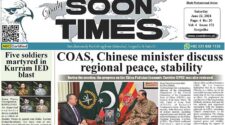China seeks to replace the United States as the most important and influential nation in the Indo-Pacific region. This strategic goal may have been an aspiration among Chinese President Xi Jinping’s recent predecessors, but it has become under Xi the engine of most of China’s day-to-day foreign policies. Convinced that the United States is in secular decline and the only questions being how fast and how far, Beijing projects its increasing economic and diplomatic power to undermine the foundations of the American posture in Asia, beginning with the U.S. alliance system. As Lee Kuan Yew, late prime minister of Singapore and supreme global strategist, emphasized, they have transformed a poor society by an economic miracle to become now the second-largest economy in the world on track, as Goldman Sachs has predicted, to become the world’s largest economy. They have followed the American lead in putting people in space and shooting down satellites with missiles. Theirs is a culture 4,000 years old with 1.3 billion people, many of great talent a huge and very talented pool to draw from. How could they not aspire to be number 1 in Asia, and in time the world? It is China’s intention to be the greatest power in the world.”
China’s tactics will change over time; its desire for dominant influence, at least in the Indo-Pacific region, will not. One sees this in the effective conciliatory speeches Xi and his senior colleagues make in international forums, which contrast vividly with former President Trump’s bitter, resentful outbursts. Indeed, Beijing remains a verbal champion of international cooperation precisely when the Trump administration largely abandoned it. This is not to say that China does not make mistakes in implementing its strategic goals through its tactical actions. Its crude, threatening “wolf warrior” diplomacy is counterproductive. The financial terms of its Belt and Road Initiative have aggrieved some countries in the developing world. China’s military actions in the Himalayas along the India-China border in the early summer of 2020 in unforgiving mountain terrain have dramatically changed public opinion in India and pushed it geopolitically closer to the United States. So this is far from an error-free team in Beijing.
The crucial variable in whether China is successful in its strategic purpose is the domestic, economic, military, and diplomatic strength and resolve of the United States and its allies, and not Chinese actions. At this writing, as the Biden administration enters office, the United States is deeply divided on political, economic, and racial issues, marked by a polarized Congress and an angry partisan public fed for years by Donald Trump’s divisive rhetoric and actions exemplified by the chaos and violence at the Capitol in Washington on January 6. In this context, President Biden has an enormous challenge to unite the country in pursuit of agreed domestic and international goals. He will benefit from available vaccines and other medical positives in the early months of his term that could lift some domestic pressure and give him more international flexibility. Should he succeed in reanimating American power and intensifying ties to allies, managing China’s rise becomes substantially less daunting, and the leaders in Beijing would likely slow their aggressive push toward Asian dominance. Should he fail, he would only reinforce the view in Beijing and in some allied capitals that the United States has joined all the other nations over the centuries that dominated the international system, then faltered, then failed.
The United States with its allies and partners can successfully compete with China, and there is no reason for intrinsic pessimism. Although the following are not perfect comparisons, they are illustrative. The combined economies of the United States, Japan, South Korea, and Australia far outstrip that of China. U.S. nominal gross domestic product (GDP) in 2019 was $21.4 trillion compared to China’s $14.3 trillion. The 2019 total nominal GDP of the United States, Japan, South Korea, and Australia was $29.5 trillion. When measured by purchasing power parity, China’s $23.5 trillion GDP exceeds the U.S. figure of $21.4 trillion, but is still behind the $30.4 trillion of the U.S.-Asian alliances. Even if the economic fallout of the coronavirus changed those numbers significantly for 2020, it is difficult to imagine that the immediate ramifications of the pandemic could close the GDP gap between China and the United States and its Asian allies. Additionally, PRC exports of goods and services in 2019 totaled $2.6 trillion, com- pared to $2.5 trillion in the United States, but U.S. allies in Asia make up almost $2 trillion in additional exports. Combined defense spending by the United States, Japan, South Korea, and Australia outpaced China in 2019. Washington spent $684.6 billion on defense and budgeted $69 billion for war funding. Japan, South Korea, and Australia combined to spend an additional $113.9 billion on defense.
China, the second biggest spender, put an estimated $181.1 billion toward defense. That said, it is difficult to quantify or accurately break down PRC military expenditures, and Beijing does not pay as much per soldier as Washington does. Of course, what matters most is what is being purchased in these budgets. China has modernized its force at a blistering pace since 2000, but U.S. allies in Asia are also increasing budgets to acquire more advanced weapons and improve their navies’ blue-water capabilities. The four now have advantages in most general military dimensions over China, including U.S. superiority in naval tonnage, higher-quality submarines, and superior long-range stealth aircraft. However, these sorts of measures of inputs shed relatively little light on who can sustain prolonged combat and where. The PRC has major advantages in its ability to sustain fighting on a large scale in the seas and airspace near Taiwan. Beijing often cannot match the united diplomacy of Washington and its allies and partners in Asia and Europe, but this situation is evolving. The United States and NATO allies the United Kingdom and France hold three of five of the permanent UN Security Council seats. Although China acquired chairmanship of four UN specialized agencies, the United States and its European and Asian allies combined hold chairmanship of six. But China does not stand idle. It is strengthening its military partnership with Russia. It maintains close relations with Iran, Pakistan, Myanmar, and North Korea. All of these except North Korea have conducted joint military exercises in several locations.
China, Russia, and Iran have carried out joint naval exercises. Russian and Chinese bombers have flown together in patrols over the Sea of Japan. Moreover, PRC economic linkages and dependencies have a value that can influence and compel behavior even among U.S. allies, the Philippines being a case in point. For instance, China recently concluded both the Regional Comprehensive Economic Partnership in Asia, which includes all five U.S. Asian treaty allies and a bilateral investment treaty with the European Union (EU). Although China is catching up, the United States still generally leads in the application of advanced technologies. Moreover, Beijing’s soft power and values appeal only to governments with authoritarian tendencies. India, although not a treaty ally of the United States, increasingly sees its capacity to avoid intimidation from Beijing as linked to ever-closer relations with the West. Further, publics in the democracies now decisively see China as a threat to their values and well-being.
In October 2020, a Pew poll showed that in twelve democracies in Europe and Asia, majorities of at least 70 percent had a very or somewhat unfavorable view of China. A report published in November 2020 by the Central European Institute of Asian Studies revealed that in all thirteen European nations surveyed, respondents had a negative view of China’s “effect on democracy in other countries.” Finally, in addition to all these factors are the many substantial domestic problems China currently faces that will to some degree constrain its external behavior.27 In short, there is much repair to be done with respect to U.S. international influence and America’s alliance systems after the Trump years, but enormous potential power resides in these nations to work together to deal successfully with China.
The United States and China are well on their way to confrontation, which could eventually lead to war. During the past two years, almost every international issue divided Washington and Beijing. They disagreed about the most effective ideological underpinnings and political structures for modern societies, the futures of Hong Kong and Taiwan, freedom of navigation and the nature of maritime claims in the South China Sea, how best to curtail the North Korean and Iranian nuclear weapons programs, nuclear weapons and arms control, cyber penetration and other influence operations, the place of alliances in the current era, bilateral trade and intellectual property, human rights, 5G networks and advanced technology, climate change, China’s Belt and Road Initiative and geoeconomic coercion, the India-China dispute in the Himalayas, and the proper roles and missions of international organizations. In the fervor of the just completed U.S. electoral season, many of these disagreements have worsened a problematical reality that the Biden administration just inherited.
In the past few years, Beijing and Washington seemed uninterested in using diplomacy to arrest the potentially catastrophic decline in their relations. Few meetings have been held between the top diplomats of the two sides, and crisis management mechanisms are moribund. Thus neither the United States nor China made any serious effort to reduce disagreements on the major issues between them. Instead, they hurled daily public accusations against the other. Secretary of State Mike Pompeo all but said that Washington could not successfully address its problems with Beijing as long as the Chinese Communist Party ruled there in short, a call for regime change. China in its media has found nothing good to say about the United States, from its racial and class problems to its international behavior. This absence of diplomacy perplexes because it widens the U.S.-China gulf and increases the likelihood of eventual violent confrontation. History is replete with examples of how such conflict-ridden policies by contending states lead to tragedy. One hopes that the Biden administration will rectify this problem.
No grand bargain will be struck between the United States and China on world order. This is especially true given that both the U.S. and Chinese governments currently strive for illusionary primacy in the Indo-Pacific.
China and United States are on the way of Confrontation









